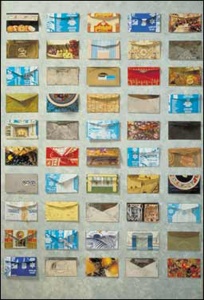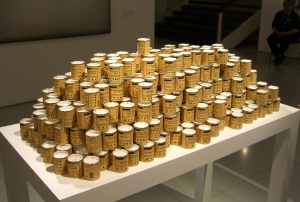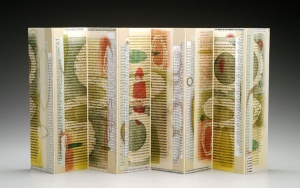Ritual and Repetition
The bedrock of all religion is repetition. Tradition as a religious concept is nothing less than the repetition of rituals, dress, thought and behavior of preceding generations. For Jews the amount of repetition that is found in one’s life naturally expresses the degree of one’s piety.
The phenomenon of repetition is calculated to have a profound effect on an individual’s religious life. Simply put, it’s purpose is to raise consciousness and imbue meaning in the simplest of daily actions. The multitude of blessings we make over food, mitzvahs, and experiences are meant to endlessly affirm God’s dominion (Blessed are You, Hashem…) and intimate involvement in our daily actions. The repetitive schedule of our prayers is similarly designed to force us to communicate with God at the very least three times daily to keep the dialogue flowing between Creator and Created. Such an obsession with repetition has its dangers however. Frequently instead of heightening consciousness our actions turn into mere rote, a dry husk of intention. There’s the rub! This is precisely the dilemma that a new mini-exhibition of 14 works addresses in Ritual and Repetition at the Jewish Museum.
These conceptual artworks demand a close visual and intellectual reading. The most successful of the works on display are rooted in the world of mitzvahs and ritual. Harley Swedler’s Derivation 36/8 (1992), is a highly unusual cast aluminum and steel Hanukkah lamp that has thirty-six receptacles that total the number of lights used over the eight day holiday. The multitudinous candle holders are set against a gentle curve of shiny aluminum etched with a verse from Isaiah 55:13; “In place of the thorn shall rise up the cypress.” The Gemara in Megillah 10b equates the thorn with Haman and the cypress with Mordechai, essentially saying that the wicked will be destroyed and the righteous will take their rule (Rashi). But isn’t this verse applicable to Purim and not Hanukkah and why add so many unnecessary places for Hanukkah lights? Visualizing the use of this menorah begins to yield meaning as we realize that one would start with thirty-six candles and gradually they would diminish, first one, then two, then three, etc. Each night the passage of time and duration of the miracle would become more and more apparent. While the traditional menorah simply acts as counter for which day of the festival we are on, Swedler’s innovation makes us feel the passage of time by the visual absence of the candles already consumed. The repetition of the mitzvah of candle lighting is made tangible by the empty holders. His choice of the verse in Isaiah forcefully links the two Rabbinic holidays of Purim and Chanukah reminding us that salvation from our enemies does not happen in an instant, rather it must be played out over time, whether eight days or the entire hidden narrative in Megillah Esther. Ritual repetition yields an expanded meaning.

Harriete Estel Berman’s Tzedakah (1999) invites us to examine our intentions in one of the most central Biblical mitzvahs. In a neat grid fifty pre-printed steel letter-sized envelopes are attached to the gallery wall. The majority of the flaps are open and the designs are taken from different kinds of tin boxes, ranging from purely decorative, the Jewish National Fund tzedakah boxes, biscuit tins, and finally plain unadorned tin. The motif of food and biscuit tins clearly resonates with the mitzvah of tzedakah; just as we ask for sustenance from God it is our duty to help sustain those in need. The tzedakah box designs recalls the repetitive sounds of coins being dropped in year after year, each one of us dutifully and perhaps mechanically performing the mitzvah.
Confronted by the host of fifty tin envelopes we are perhaps a bit overwhelmed by the clamoring voices of need. And then we notice some of the flaps are embossed with tiny messages that force the viewer to peer closely to see the text on each one. Each is different and represents different performance and intention of the mitzvah:
Giving secretly with the donor knowing the recipient but the recipient not knowing the donor. Helping the needy to become independent by advancing money or providing opportunities. Giving before request is made with donor and the recipient not knowing each other. Giving without knowing the recipient but the latter knows the donor. Giving less than is needed and without kindness or grace. Giving only after a request is made.
This artwork slowly but surely entangles us in the many aspects of tzedakah and demands that we examine not only what we are doing but why, over and over again. Each day, sometimes many times a day, we fulfill the commandment to give charity. We now understand that this repetitive act must be closely examined, again and again.

The artwork that takes the notion of Ritual Repetition the most literally is Dov Abramson’s Ner Mitzvah (2003). Six hundred and thirteen yahrzeit candles are arranged atop one another, each meticulously and mechanically labeled and coded according to type of mitzvah, penalty, applicability, etc. The genius of this work is that it compresses the halachic universe into a symbolic whole visible at one glance. As I reviewed this work in July 2005; “Simultaneously the work exposes the vulnerabilities of the halachic system; the tendency for rote performance and hollow symbols, by creating mechanically reproduced labels, each a carbon copy of the next except for textual variations. Abramson’s work warns against mechanically produced mitzvot, mechanically lived Jewish lives.” Repetition can deaden our very link to spirituality.


Finally the technique of repetition can be an extremely effective tool to penetrate a horror too terrible to bear. Lynne Avadenka created Aftermath I (2003) in response to the September 11, 2001 attack on the World Trade Center. She is a book artist and therefore created an accordion style book, sixteen sides in all comprising collage, hand drawn designs and many columns of vertical text, some right side up and others upside down. The text she uses is simple and riveting. We see repeated over and over fragments and whole phrases from Sir Isaac Newton’s First Law of Motion; “An object at rest tends to stay at rest and an object in motion tends to stay in motion…” This is contrasted with similar fragments from Jacob’s dream: “A ladder was set on the earth and its top reached the heavens and the angels of God were going up and coming down.” Immediately the vertical shapes of the book and their prophetic texts summons the burning twin towers and the terrible images we cannot forget of bodies falling, falling, falling until the buildings themselves fell. The effect is hypnotic, reading two texts that repeat over and over again like some kind of terrible dirge, a kinos to our terrible times.
This is the season, above all others, for repetition. Two days of Rosh Hashanah, 100 shofar blasts each, shacharis, mussaf, mincha and maariv repeated, Yom Kippur even adding Neilah and twelve confessions repeated throughout the day. Till the last shofar blast at the end of Yom Kippur we should, just like these works of art try to, squeeze each repetition for its insights and precious meaning.
Ritual and Repetition
Contemporary Gallery of Culture and Continuity
Jewish Museum
1109 Fifth Avenue, New York, N.Y.